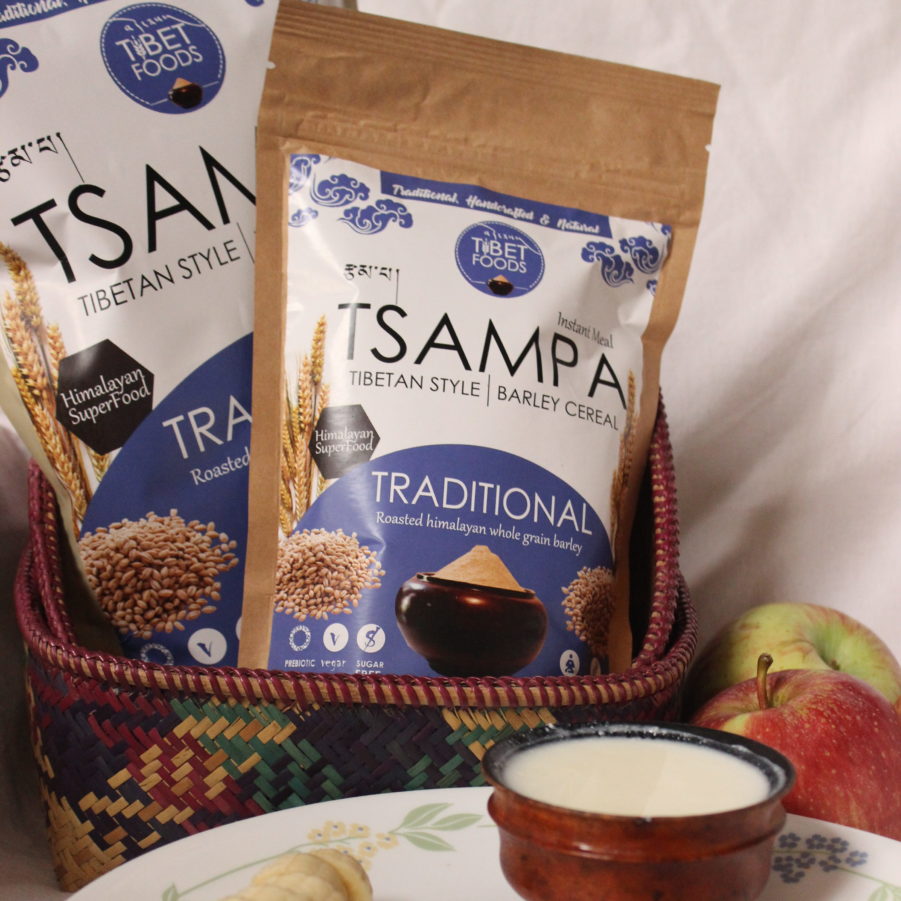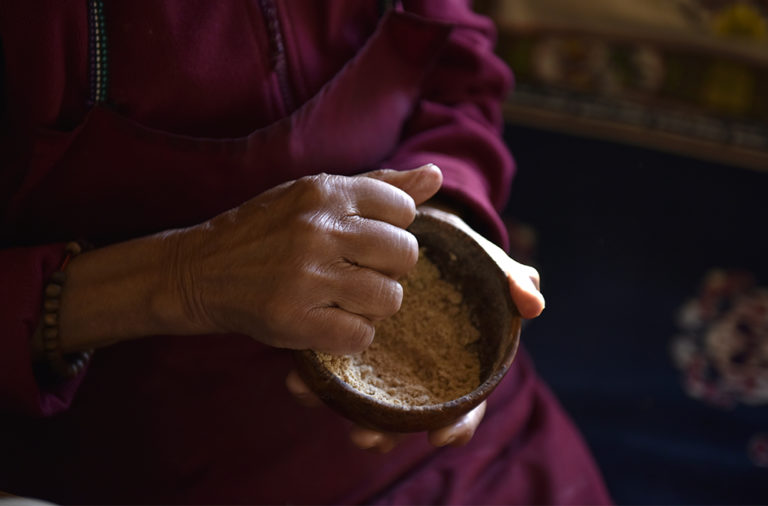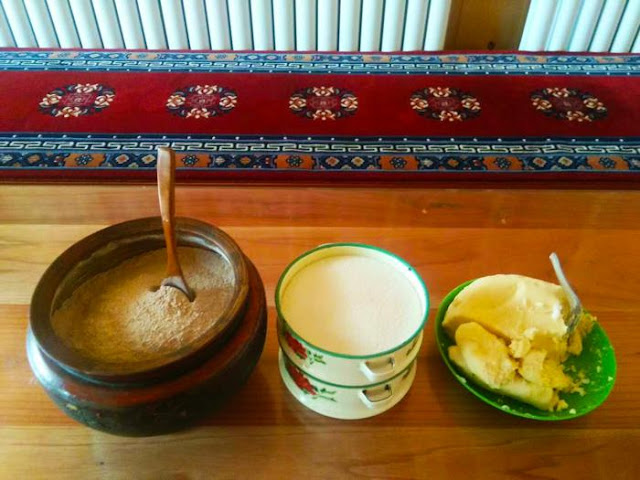When you ask ordinary Indians about Tibetan food items, you would typically hear answers like Momos, Chow Mein (no relation to Tibetan cuisine) and Thukpa. But the ultimate staple food of the Tibetan community and others residing in the high-altitude regions of the Himalayas ranging from Ladakh to Arunachal Pradesh is the simple ‘Tsampa’ or ‘Tsamba’, a nutty-tasting flour made from roasted barley, which allowed past generations to survive harsh climates.
Often consumed with salted butter tea or cheese, salt and yak milk, Tsampa is what many Tibetans consider their ‘true food’ – rich in nutrition and an integral part of their heritage.
“Growing up in a Tibetan refugee settlement in Ladakh, eating Tsampa was an integral part of our everyday life since the time we were born. It’s a staple food for us. Our parents would regularly serve us Tsampa and Cham-dur (‘Tsampa porridge’). Tsampa has immense health benefits since it’s high in fibre and essential minerals. But as children, we would consume it without really thinking about the health benefits,” says Tsering Dekey (36), a former public relations professional who runs Tibet Foods, speaking to The Better India.
Tibet Foods is a startup Dekey founded in June 2019 alongside her husband, Tehor Wangdue Dorjee (41), member of parliament, CTA (Central Tibetan Administration)/Tibetan Government In-Exile and a social worker.
(Image above of Tsering Dekey and her husband Tehor Wangdue Dorjee, co-founders of Tibet Foods)
Wangdue was never quite fond of Tsampa as a child growing up in the Bir Tibetan Colony, located in the Bajinath Valley of Himachal Pradesh.
“To be very honest, I was not fond of Tsampa. However, my perception has changed since I’ve been looking after my ageing and diabetic parents for about 15 years in Bir village. Diabetic patients have so many restrictions regarding what kind of foods they can consume. Indian doctors used to recommend Tsampa and other healthy barley products. Even our sowa rigpa (Tibetan traditional medicine) practitioners would highly recommend Tsampa to my parents. This was when I was attracted to Tsampa,” recalls Wangdue.
Given the health benefits of Tsampa and its ancient association with Tibetan culture, Wangdue went on to research the availability of the nutritious barley in India and found that the best grades were found in the higher altitudes of the Himalayas.
As this NPR report notes about Tsampa’s health benefits, “Because the barley used in tsampa doesn’t have to be heavily processed, it retains more nutrients, and the flour’s healthfulness rivals that of other ancient grains. Tsampa is high in fiber and essential minerals and it’s prebiotic, meaning it helps promote the growth of healthy gut bacteria. It has a low glycemic index, which helps keep blood sugar from spiking.” It’s also after all, what His Holiness the 14th Dalai Lama has for breakfast every morning according to certain reports.
Even before their marriage in 2017, both Dekey and Wangdue would share ideas about Tsampa, its health benefits and the idea of establishing a venture around it. Then, two years after their marriage, Tibet Foods was born.
Today, out of a small manufacturing unit in their home in Bir, Tibet Foods makes and sells packets of traditional Tsampa and Ney-Thuk (Barley Porridge) and distributes it all over India, while it has a variety of Tsampa Cookies and Barley Tea ready for production next month.

Origin Stories
Both Dekey and Wangdue are products of the Tibetan Children’s Village (TCV) schools built throughout India by Jetsun Pema, the sister of His Holiness, the 14th Dalai Lama. These were institutions where thousands of refugee children from Tibet and other Himalayan regions found a decent education and maintained their Tibetan Buddhist roots.
Following her stint in TCV-Bylakuppe in Karnataka, Dekey finished college at the Bishop Cotton Women’s Christian College in Bengaluru, while Wangdue completed his graduation from Panjab University. After college and another short course, Dekey became a public relations professional working for agencies in Delhi and freelancing.
Following a successful stint in public relations, she founded her venture in Dharamshala called Yakoooh. This online e-commerce platform aims to bring Himalayan arts, lifestyle, nature expeditions and crafts more easily to consumers in India and the world. Meanwhile, Wangdue worked in the United States for a brief while before returning home to take care of his parents and become a social worker to serve his community and H.H. The Dalai Lama.
In fact, during the first wave of the COVID-19 pandemic, Wangdue played a stellar role in making face shields out of bookbinding sheets (March 2020) and distributing them to frontline workers all over Himachal Pradesh, Delhi Police, Tibetan settlements, Sowa Rigpa Clinics (Mentsekhang) in India and TCV schools across India.
Working in coordination with the International Buddhist Confederation (IBC), he also helped provide oxygen concentrators, ventilators, oxygen cylinders and other medical equipment to many Tibetan settlements during the second wave of Covid-19 from May 2021 onwards. Sponsorship for the same also came from the IBC. But while he was actively working for the Tibetan community during the pandemic, the venture never stopped.
“Wangdue was the brain behind Tibet Foods. Even before we got married, we talked about establishing a startup like this one. He would share a lot about Tsampa and how it’s helpful for his parents. Before our marriage, we were doing a lot of research about barley porridge and Tsampa. Once we got married, we put all these ideas into production,” says Dekey.
“We (Tibetans, Ladakhis) are used to eating Tsampa because it’s part of our everyday lives. Nobody has to teach us how to prepare it. Outsiders, however, might find the process a little messy while consuming it. Since barley is very nutritious and a staple food, we felt a responsibility to promote our Himalayan and Tibetan traditional foods to a larger market, but at the same time figure out how we can make the process of making it for outsiders more convenient. The main aim of Tibet Foods is to innovate old Tibetan and traditional Himalayan foods according to modern tastes and lifestyles but keep the original taste intact. At the same time, we hope to create job opportunities in refugee Tibetan settlements and support farmers in Ladakh and Spiti from where we source 100% high-grade organic barley,” says Wangdue.
Dekey goes on to add, “We look after the quality of our product, especially the raw materials which we collect from places above 4,200 metres above sea level. This is one of the USPs of our product. We also conduct regular quality checks before dispatching our products.”

How do you make and consume Tsampa traditionally?
According to this blog post on ‘Simply Tibetan, Simply Delicious’, the process of making Tsampa isn’t quite as straightforward. Once quality barley grains are sourced from high altitude locations like Ladakh, two or three people would commence washing it, which is tedious and time-consuming.
Following the washing process, the barley grain is roasted. “The washed and dried barley is roasted in hot sand until the barley is cooked through – like popcorn, one can smell the roasted barley or ‘yoe’ as we call it,” notes the blog. The final step involves grinding the roasted barley into Tsampa flour, which is best done in a water mill.
However, Dekey has a slightly different approach.
“We don’t roast the barley grain on hot sand or salt. We just roast it on a dry pan. If we roast it on the sand, there is a chance of many impurities mixing with the barley – like small stones. For Ney-Thuk, we roast the barley in the same way as traditional Tsampa but grind it further. The resultant product has the taste of barley but in porridge form. We also mix a little bit of Himalayan Pink Salt into our traditional Tsampa and Ney-Thuk. Our elders used to mix a little bit of gur (jaggery) in the Tsampa to ensure a longer shelf life. But we feel that if we put jaggery (a sweetener), we might compromise the nutritional value. So instead, we add a little natural preservative,” she explains.
There are a couple of basic ways of consuming Tsampa.
According to the British adventurer, journalist, soldier and travel writer Peter Fleming, who visited Tibet in the early 20th century: “You fill your shallow wooden bowl with tea, then you let the butter melt in the tea (the butter is usually rancid and has a good cheesy flavour); then you put a handful of tsamba in. At first, it floats; then, like a child’s castle of sand, its foundation begins to be eaten by the liquid. You coax it with your fingers until it is more or less saturated and has become a paste; this you knead until you have a kind of doughy cake in your hand and the wooden bowl is empty and clean. Breakfast is ready.”
As this delightful article titled ‘In Defence and Tibetan Cooking (Part 1)’ on Shadow Tibet goes on to explain: “The watchword is ‘coax’. You have to go about the process slowly and gently, ‘folding’ the tsampa into the tea like you would fold melted chocolate into egg-white when making chocolate mousse. Tibetans don’t use the word ‘knead’ (zi) for the process of preparing tsampa for eating. The word used is ‘yoe’ which would mean blending or mixing but, I repeat, done gently. When prepared in this fashion, you get a mixture that is not sticky or doughy but soft and manageable. This end-product is now called paag [in Ladakh it’s colloquially known as ‘Kholak’], not tsampa anymore. You can then make convenient lumps of the stuff, ready to be eaten, without tsampa sticking all over your hands and everywhere. A small lump or roll of paag squeezed in your fist is called daga.”

Professional Tsampa Makers
“Both of us weren’t professional Tsampa makers starting out, but now we are thanks to time and experience. We have customised our machines to make Ney Thuk or Tsampa. In 2019, we ordered an oat roller machine from Canada, where my sister lives. Once we acquired it, we did some research and customised this machine to our needs in Delhi. We have a small manufacturing unit here in Bir at our residential quarters. For deliveries, we use the government postal service. We do the processing, packaging and marketing at home,” notes Wangue.
Having said that, the pandemic proved to be a real struggle for the couple.
“When we introduced our products in 2019, we received a very good response. Our products made their way to Mcleodganj, Karnataka, Darjeeling and Kalimpong as well. During the pandemic, the number of orders slowed down. But there was still some consistency in order deliveries, although not as much as we had before the pandemic. The pandemic was a real struggle, and even today, it feels like we’re just starting,” says Dekey.
Going forward, the couple is first targeting the (Tibetan) Buddhist community in India since there is little requirement to promote or advertise Tsampa to them.
“We are not yet at the stage as a startup to promote it massively. Once we hit these markets, our main goal of promoting traditional Tibetan/Himalayan foods will be targeted at the major cities of India. The final destination is the international market. Our key objective is to share the secret of other Tibetan healthy superfoods to the world,” claims Wangdue.

For the couple the promotion of Tsampa goes beyond commerce.
It’s deeply ingrained in Tibetan culture. Back in the past, Wangdue recalls how Tsampa was the first solid food many Tibetans would eat as babies. “We offer Tsampa to our gods and during different occasions like celebrating the birth of a child. We would also offer Tsampa to the spirits of the people who die. Back when there was no modern medicine and someone was sick, they would make paag (doughy cake made from barley flour) and place them on the eyes, ears and different orifices of the body to regenerate ‘energy’ within the sick body. In fact, there is a proverb in Tibetan which loosely refers to Tsampa as ‘White Medicine’,” he explains.
It’s more than promoting Tibetan healthy superfoods, but introducing an intimate part of their culture and heritage to the wider world as well.
(You can order your packets of Tsampa on the Tibet Foods website.)
(Edited by Vinayak Hegde)
No comments:
Post a Comment